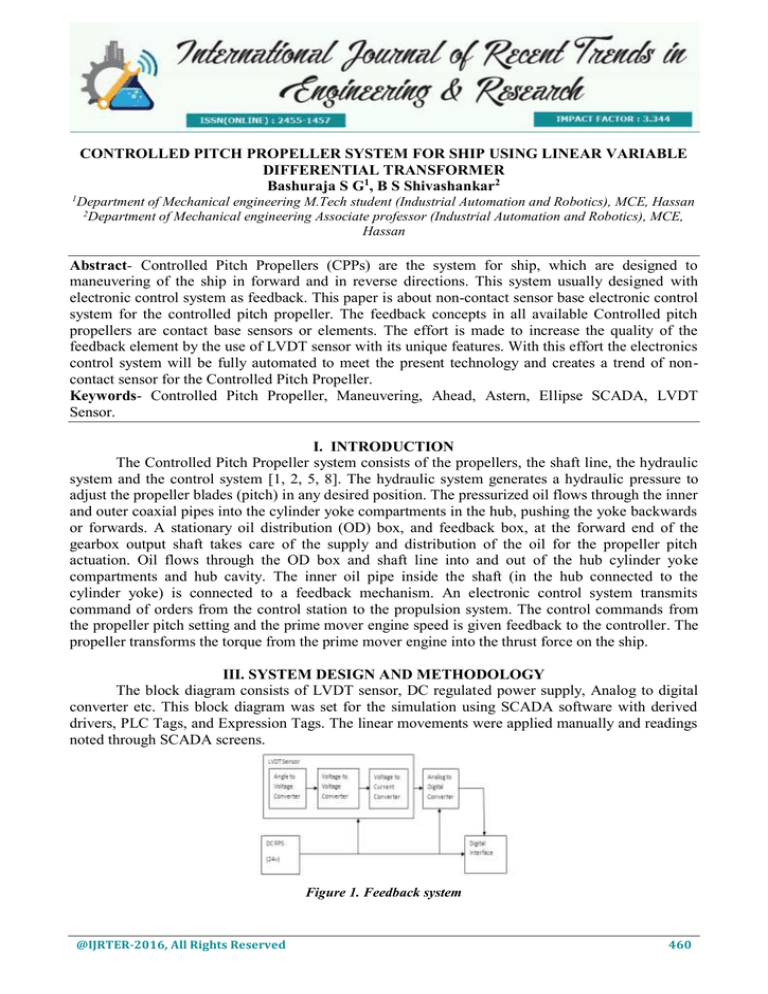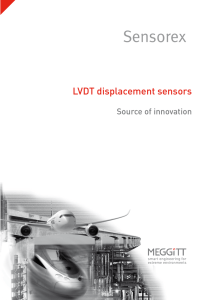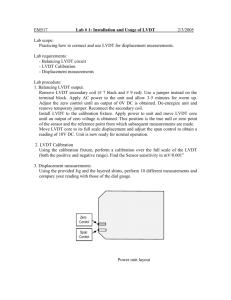
CONTROLLED PITCH PROPELLER SYSTEM FOR SHIP USING LINEAR VARIABLE
DIFFERENTIAL TRANSFORMER
Bashuraja S G1, B S Shivashankar2
1
Department of Mechanical engineering M.Tech student (Industrial Automation and Robotics), MCE, Hassan
2
Department of Mechanical engineering Associate professor (Industrial Automation and Robotics), MCE,
Hassan
Abstract- Controlled Pitch Propellers (CPPs) are the system for ship, which are designed to
maneuvering of the ship in forward and in reverse directions. This system usually designed with
electronic control system as feedback. This paper is about non-contact sensor base electronic control
system for the controlled pitch propeller. The feedback concepts in all available Controlled pitch
propellers are contact base sensors or elements. The effort is made to increase the quality of the
feedback element by the use of LVDT sensor with its unique features. With this effort the electronics
control system will be fully automated to meet the present technology and creates a trend of noncontact sensor for the Controlled Pitch Propeller.
Keywords- Controlled Pitch Propeller, Maneuvering, Ahead, Astern, Ellipse SCADA, LVDT
Sensor.
I. INTRODUCTION
The Controlled Pitch Propeller system consists of the propellers, the shaft line, the hydraulic
system and the control system [1, 2, 5, 8]. The hydraulic system generates a hydraulic pressure to
adjust the propeller blades (pitch) in any desired position. The pressurized oil flows through the inner
and outer coaxial pipes into the cylinder yoke compartments in the hub, pushing the yoke backwards
or forwards. A stationary oil distribution (OD) box, and feedback box, at the forward end of the
gearbox output shaft takes care of the supply and distribution of the oil for the propeller pitch
actuation. Oil flows through the OD box and shaft line into and out of the hub cylinder yoke
compartments and hub cavity. The inner oil pipe inside the shaft (in the hub connected to the
cylinder yoke) is connected to a feedback mechanism. An electronic control system transmits
command of orders from the control station to the propulsion system. The control commands from
the propeller pitch setting and the prime mover engine speed is given feedback to the controller. The
propeller transforms the torque from the prime mover engine into the thrust force on the ship.
III. SYSTEM DESIGN AND METHODOLOGY
The block diagram consists of LVDT sensor, DC regulated power supply, Analog to digital
converter etc. This block diagram was set for the simulation using SCADA software with derived
drivers, PLC Tags, and Expression Tags. The linear movements were applied manually and readings
noted through SCADA screens.
Figure 1. Feedback system
@IJRTER-2016, All Rights Reserved
460
International Journal of Recent Trends in Engineering & Research (IJRTER)
Volume 02, Issue 05; May - 2016 [ISSN: 2455-1457]
The letter LVDT stands for a Linear Variable Differential Transformer, a common type of
electromechanical transducer. This converts the change in linear motion changes a core in a coil
assembly, which is coupled mechanically into a corresponding electrical signal. LVDT internal
structure is shown in figure 2. The LVDT Sensor is designed with primary and secondary coils,
which induces current at both primary and secondary windings. In CPP there are only two positions
(i.e., Ahead and Astern) can be at primary and secondary coils, output can be easily taken and
processed according to the requirement. Linear Variable Differential Transformer sensors are readily
available that can measure movements as small as a few millionths of an inch up to several inches,
but are also capable of measuring position up to +20inches or -20 inches.
Figure 2. LVDT construction
Figures 3 illustrate the working principle of LVDT. It consists of one primary winding, two
secondary windings and a core [3]. A core will be varying according to the magnetic flux is
developed by the secondary windings. The primary winding P is energized by the constant source.
The magnetic flux thus developed is coupled by the core to the adjacent secondary windings called
S1 and S2. If the core is located midway between S1 and S2, then equal flux will be coupled to each
secondary windings and their corresponding voltages are E1 and E2. Induced voltages in windings
S1 and S2 respectively are equal. This position is called as Null Point differential voltage output (E1E2), is essentially zero.
Figure 3. LVDT in Null Position
If the core is moved right closer to the winding S2 than to S1 as shown in figure 4, more flux
will be coupled at S2 than at S1, that induced voltage E2 is increased while E1 is decreased, resulting
in the differential voltage (E2-E1).
@IJRTER-2016, All Rights Reserved
461
International Journal of Recent Trends in Engineering & Research (IJRTER)
Volume 02, Issue 05; May - 2016 [ISSN: 2455-1457]
Figure 4. Core movements to right
Conversely, if the core is moved left towards S1 as shown in figure 4, more flux will be
coupled to S1 and less at S2, and hence the voltage E1 is increased as E2 is decreased, resulting in
the differential voltage (E1-E2).
Figure 5. Core Movement to left
The figure 6 shows the graphical reperesentation of core and is classified as A, B and C. A
represents magnitude of differential output voltage at Eout, B represents phase angle changes made
by the core and C reperesents phase shift of 180 degrees.
Figure 6. LVDT’s Core movements in Graphical Representation
LVDTs are robust, absolute linear position displacement transducers inherently frictionless.
They have a virtually infinite cycle life when properly used. LVDTs have been widely used in
@IJRTER-2016, All Rights Reserved
462
International Journal of Recent Trends in Engineering & Research (IJRTER)
Volume 02, Issue 05; May - 2016 [ISSN: 2455-1457]
applications such as power turbines, hydraulics, automation, aircraft, satellites, nuclear reactors, and
many others. These transducers have low hysteresis and excellent repeatability.
IV SIMULATION & ANALYSIS
Simulation and Analysis is done by using ELIPSE SCADA Software. SCADA stands for
Supervisory Control and Data Acquisition. Ellipse software is proud to present the powerful tool for
creating and developing supervisory control applications. Ellipse SCADA gives a great performance
and has powerful and innovative features to make the task of developing applications easier. It is
completely configurable by the user and the process variables can be shown in a graphic form,
allowing an easy understanding of what is going on in real time. The real time data can be interpreted
to the user by using multiple screens such as Bars, Trends, Displays, Gauge, etc simultaneously on
single screen. Besides this can send or receive information to data acquisition equipment using Set
points, Sliders, and Buttons.
4.1. Ellipse SCADA Screen
Ellipse SCADA screen can configure too many other screens as shown in figure 7. Graphical
representation and conversion screens. Here CPP screen displays or conveys pitch angles movement
in degree (34.30 degree) and similar converted values to that pitch angle of degrees to corresponding
current values in mA. This current value goes on changing according to changes occurred in the
pitch angles.
Figure 7. Pictorial view of SCADA Simulation
Simulation is performed with LVDT. The hardware components used for simulation were
MASIBUS (Process indicator with MODBUS RTU Interface), RS485 to USB Converter, LVDT
Sensor, DC 24v Regulated Power Supply. Here main effort is to achieve the conversion of angle
movements to their corresponding voltage values. Then the voltage is converted into current in terms
of mA.
Since requirement was only for one PLC tag and one Expression tag. Hence PLC tag was
configured with N addressing parameters according to selected MODBUS driver and scanned time
set for updating values on the screens.
@IJRTER-2016, All Rights Reserved
463
International Journal of Recent Trends in Engineering & Research (IJRTER)
Volume 02, Issue 05; May - 2016 [ISSN: 2455-1457]
Table 1.LVDT Simulation Readings
Pitch Angle
-24.21
-20
-15
-10
-5
0
5
10
15
20
25
30
35.36
Current in mA
4.030
4.158
6.501
7.844
9.187
10.530
11.873
13.216
13.559
14.902
17.245
18.588
20.011
The N addressing parameters specify the nodal address of the RTU. The data values from register
along with scan time are displayed on the screen. The MODBUS driver was also configured to read
the required serial port (COM1) and the operational code was set as per the MODBUS RTU. Tags
could read the input register values from the slave RTU with ID 01, function code 03 and data type
integer (6, 4). Also the expression tag was generated from the PLC tag for displaying the current
values in mA.
V. RESULT & DISCUSSION
The results obtained from the LVDT sensor signals in terms of milli Amperes (mA) and also
pitch angles. Hence operational wise feedback system with a Linear Variable Differential
Transformer has many advantages such as:[7] the LVDT sensor over the other types of sensor is the
high degree of robustness, because there is no physical contact across the sensing element, there is no
wear in the sensing element. The LVDT device relies on the coupling of magnetic flux leads to have
an infinite resolution. Therefore the smallest fraction of the movement can be detected by suitable
signal conditioning hardware, and the resolution is determined by the resolution of the data
acquisition system. Some of other advantages are listed below:
1. High repeatability
2. High sensitivity
3. Very good linearity
4. Ruggedness
5. Low hysteresis
6. High shock and vibration immunity
7. Non-contacting core sensing technology.
V. CONCLUSION
Electronic Feedback control system plays a vital role in the Controlled Pitch Propeller since
the manoeuvring of the overall system depends on the outcome of this system. The method explained
in the paper helps to improve the life of the feedback system by providing reliable components. The
use of LVDT sensor and other advanced automated components in the system provides high
reliability, easy installation and less maintenance.
@IJRTER-2016, All Rights Reserved
464
International Journal of Recent Trends in Engineering & Research (IJRTER)
Volume 02, Issue 05; May - 2016 [ISSN: 2455-1457]
REFERENCES
1.
2.
3.
4.
5.
6.
7.
8.
Masanori Ito, Feifei Zhang, Hiroshi Sato, Shigeo Mita and Kyoko Narukawa, “Development of Inverter-less FPP
Electric Propulsion System”, Conference Record at IEEE Industry Applications Conference, Biejing, 2000.
Aslaug Grovlen and Thor .I. Fossen, “Nonlinear Control of Dynamic Positioned Ships Using Only Position
Feedback: An Observer Back stepping Approach”, Proceedings of the 35th Conference on Decision and Control
Kobe, pp 9988-3393 Japan, 1996.
Liu Sheng and Zheng Xiuli Li Jialai, “The Cooperative Motion on Control Forward and aft Variable Vector
Propeller of a Ocean Submarine”, International conference on Mechatronics and Automation, pp 232-237 China,
2007.
Yang Yang, Chen Guo, Jian-bo Sun, & De-wen Yan, “A Novel Simulation System for Marine Main Diesel
Propulsion Remote Control”, Preceding of International Conference on Virtual Reality and Visualization, pp 57-62
Beijing, 2011.
Hauang Bin, Wang Yongsheng, “Study on the Engine- CPP Associated control Approach During Ship Accelerating
Process”, International Conference on Consumer Electronics, Communication and Networks (CECNet), pp 44734477 Xian Ning, 2011.
Ryszard Arendt, “Simulation Investigations of Ship Power Systems”, 10th International Conference on Environment
and Electrical Engineering (EEEIC), pp 1-4 Rome, 2011.
Lei Zhengling, Guo Chen1 and Liu Yang, “ADRC Controller Used in Dynamic Positioning System of a Rescue
Ship”, 10th World Congress on Intelligent Control and Automation (WCICA), Beijing, 2012.
Huixiong Wan, Rui Lin, and Haibo Huang, “Research on All-digital Strip Steel Rectifying Electro hydraulic Control
System”, Proceedings of IEEE International Conference on Mechatronics and Automation, pp 232-237 China, 2009.
@IJRTER-2016, All Rights Reserved
465




